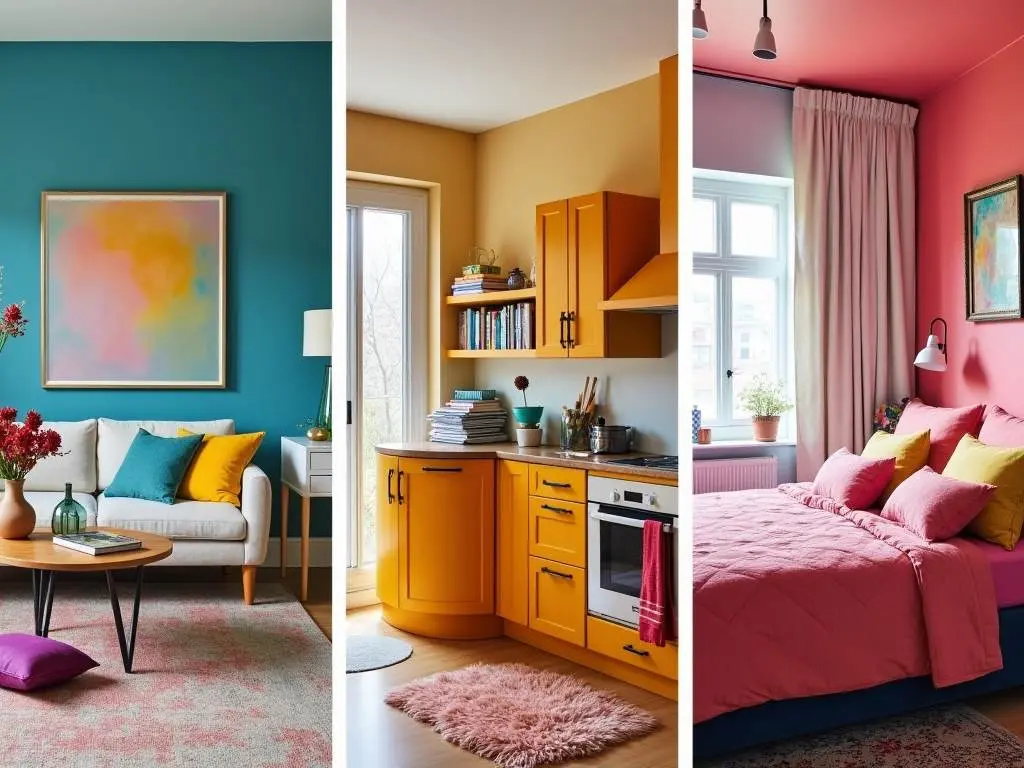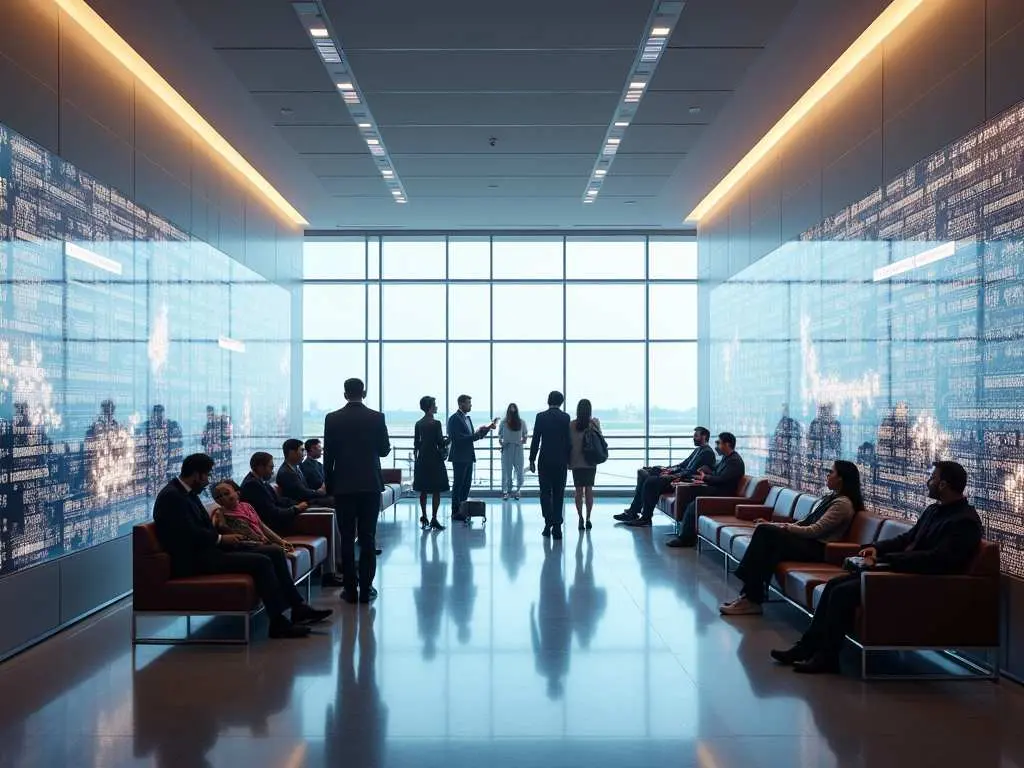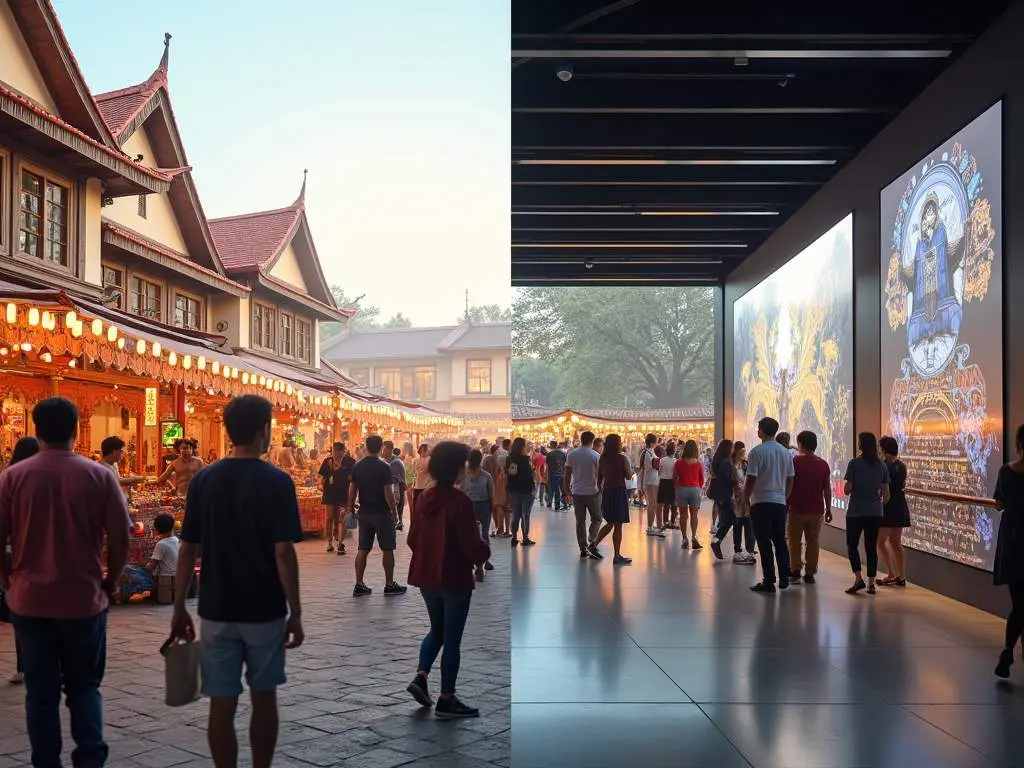Share
As an interior designer passionate about cultural expression, I’ve observed how spatial design influences social dynamics. At Curvspace, we enhance cultural experiences by crafting spaces that invite vibrant interactions. This article delves into design techniques that elevate both social and cultural experiences. What happens when varied needs converge in one space? Explore design techniques that balance complexity with unity to create engaging hubs.
Jump to:
The Essence of Vibrant Interactions in Cultural Design
Vibrant interactions are the cornerstone of thriving cultural experiences. They encompass the dynamic exchanges, shared moments, and spontaneous connections that occur within a space, fostering a sense of community and belonging. Cultural design aims to create environments that not only accommodate but also stimulate these interactions, turning spaces into hubs of social engagement and cultural expression.
Understanding the Impact of Architecture on Human Behavior
Architecture profoundly impacts human behavior, shaping our thoughts, emotions, and actions, often without our conscious awareness. The arrangement of physical spaces influences our moods and behaviors. Well-designed workspaces with ample natural light can boost productivity, while cluttered environments can cause stress. Similarly, the layout of public spaces, such as parks, influences social interactions and community engagement. Thoughtful spatial organization can foster collaboration, support personal well-being, and encourage innovation.
Key Design Principles for Fostering Social Engagement
Several design principles can be employed to foster social engagement within cultural spaces:
- Inclusivity and Accessibility: Spaces should be designed to be accessible to all individuals, regardless of age, ability, or background.
- Flexibility and Adaptability: Spaces should remain relevant and adaptable to changing community needs, ensuring they can accommodate a variety of activities and events.
- Emphasis on Local Identity: Highlighting local history, culture, and identity creates a unique sense of place and fosters community pride.
- Strategic Lighting: Lighting improves visibility, highlights key features, and sets the ambiance, creating a welcoming atmosphere.
- Integration of Public Art: Incorporating art installations, sculptures, and murals reflects the precinct’s identity and encourages social interaction.

- Comfortable Seating Areas: Providing seating areas that accommodate both individuals and groups encourages people to linger and interact.
- Open and Transparent Designs: These break down barriers between private and public spaces, encouraging social interactions.
- Community-Oriented Facilities: Spaces like libraries and community centers bring people together for various activities, fostering social cohesion
The Role of Urban Design in Shaping Communities
Urban design plays a crucial role in shaping communities by creating spaces that enhance the quality of life and promote social interaction. Streets designed for people, with wide sidewalks, trees, and public art, invite people to stroll, shop, and chat. Parks and green spaces offer residents places to relax, play, and meet, reducing stress and enhancing social cohesion. Mixed-use developments, where residential, commercial, and recreational spaces coexist, encourage people to live, work, and play in the same neighborhood, leading to more frequent social interactions.
Embracing Vibrant Colors in Interior Design

Color holds the power to transform a space, evoke emotions, and reflect the personality of its inhabitants. While neutral palettes are timeless, vibrant colors can inject energy, creativity, and a sense of adventure into living spaces.
- Start Small with Accents: Use colorful throw pillows, vibrant artwork, or an eye-catching area rug to add pops of color without overwhelming the room.
- Create a Focal Point: Choose one wall as a focal point and paint it with a bold, attention-grabbing color to serve as a backdrop for artwork or furniture.
- Experiment with Color Psychology: Understand that warm colors like reds and oranges can create a cozy, energetic atmosphere, while cool blues and greens promote relaxation.
- Play with Complementary Colors: Pair colors from opposite sides of the color wheel, such as blue and orange, or purple and yellow, to add contrast and vibrancy.
- Embrace Monochromatic Themes: Use various shades of a single color to create a harmonious and visually pleasing look.
- Balance with Natural Elements: Incorporate natural materials like wood, stone, and plants to balance the intensity of vibrant colors and add texture and warmth.
- Take Cues from Art and Nature: Draw inspiration from favorite paintings, landscapes, or even fashion for color combinations.
Cultural Spaces: Merging Tradition with Technology
Integrating tradition with cutting-edge technology in cultural spaces revolutionizes how audiences engage with art, history, and performance. Museums, theaters, and galleries increasingly employ interactive design to create dynamic experiences that captivate visitors and deepen their understanding of cultural narratives. Digital exhibits, interactive installations, and augmented reality (AR) are crucial elements that enrich these spaces, making them more engaging and educational.
Case Studies of Successful Interactive Spaces
Modern architecture embraces user-centered designs to create interactive spaces that engage and stimulate the community.
- The High Line, New York City: This linear park, built on an elevated freight rail line, encourages social interaction, relaxation, and artistic expression.
- Bloomberg European Headquarters, London: Designed with open-plan layouts, dynamic meeting areas, and interactive screens, this building promotes communication and collaboration.
- Serpentine Pavilion, London: This annual platform for experimental architecture invites public engagement and interaction through innovative temporary structures.
Curvspace and the Qualities of Bridges
Bridges exemplify Curvspace principles, embodying intermediate, open-ended, and flowing characteristics. Unlike private residential structures, bridges serve communal purposes, linking places and people. They are shared spaces influenced by multiple stakeholders, reflecting diverse interests and fostering emotional, behavioral, and social dynamics. Curvspace aims to inspire new perspectives on bridges, emphasizing their potential to enhance communal experiences and integrate seamlessly with their environments. Design philosophies mirror regional values; Asian bridges prioritize symmetry and integration with landscapes, while Western designs emphasize functionality and grandeur.
Harnessing Social Energy in Transitional Spaces

Transitional spaces, the in-between areas connecting different parts of a building or urban environment, have immense potential to foster social interaction and community engagement. Thoughtful design of these areas can create opportunities for spontaneous encounters, cultural expression, and shared experiences.
- Flexible Seating Arrangements: Versatile seating options can accommodate different group sizes and activities, encouraging spontaneous gatherings.
- Interactive Art Installations: Art pieces can invite engagement and spark conversations, serving as focal points for community interaction.
- Biophilic Design Elements: Natural elements create a calming atmosphere, promoting well-being and making spaces more appealing for social interaction.
- Lighting as a Social Catalyst: Lighting design can create ambiance, highlight gathering areas, and create a welcoming atmosphere.
People Also Ask
How can interior design promote cultural identity?
Interior design can promote cultural identity by incorporating local art, materials, and design elements that resonate with the community’s heritage, creating spaces that become powerful symbols of shared culture and history.
What role does lighting play in social spaces?
Lighting plays a crucial role in setting the ambiance and defining different zones within a social space. Thoughtful lighting can guide movement, highlight gathering areas, and create a welcoming atmosphere that encourages people to linger and interact.
Why are transitional spaces important for community engagement?
Transitional spaces serve as bridges between public and private realms, offering unique opportunities to blend the two in ways that encourage social interaction. These spaces can foster spontaneous encounters, cultural expression, and shared experiences that strengthen community bonds
Conclusion
By understanding the principles of vibrant interactions and implementing thoughtful design strategies, we can transform cultural spaces into dynamic hubs of social engagement and cultural expression. At Curvspace, we are dedicated to creating spaces that not only meet functional needs but also inspire meaningful connections and enrich community life. Contact Curvspace today to discover how our designs can elevate your cultural experiences and foster vibrant interactions within your community.
References
- Lin, Y. (2007). A Framework for Designing in Cross-Cultural Contexts. [PDF] Available at: https://conservancy.umn.edu/server/api/core/bitstreams/4ed71536-8c22-4576-9743-8f968b31638e/content
- Maptionnaire. (2024). Community Engagement in Planning and Design. Available at: https://www.maptionnaire.com/blog/community-engagement-in-planning-and-design
- The American Journals. (2024). The Influence of Culture and Heritage on Architecture. Available at: https://www.theamericanjournals.com/index.php/tajiir/article/view/5373
- Propulsion Technology Journal. (n.d.). Architectural Expression and Identity: Case Studies in Iconic Buildings. Available at: https://www.propulsiontechjournal.com/index.php/journal/article/download/1127/792/1933
- LinkedIn. (2023). How to Design for Social Engagement and Participation. Available at: https://www.linkedin.com/advice/0/how-can-you-design-increase-social-engagement-participation-9ckoe
Disclosure
Our content is reader-supported. This means if you click on some of our links, then we may earn a commission. Commissions do not affect our editor’s opinions or evaluations. Learn more about our editorial process.

About the Editorial Staff
The Curvspace editorial team comprises a diverse group of experts on intermediate and threshold spaces in homes and workplaces. Architects and interior designers, civil engineers and artists, environmental and behavioral psychologists, sociologists and anthropologists. All collaborate to create helpful content, that explores the full potential of these often-overlooked areas to enhance our daily lives.


